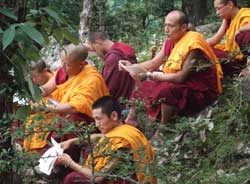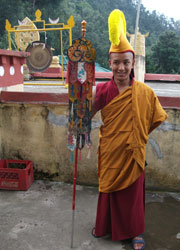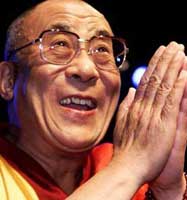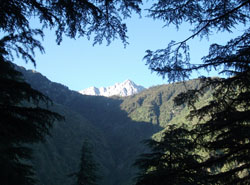Situated just below 2,000 metres in the north-western corner of Himachal Pradesh, India, the former British administrative hill station of McLeod Ganj – annexed after the Second Anglo-Sikh War and named after a Scottish Lieutenant Governor of the Punjab, Sir Donald Friell McLeod – should by rights be a model of sleepy, Anglo-Indian quaintness. Yet, in the course of the last 50 years, it has become an international capital of Tibetan culture and Vajrayana tantric Buddhism – and a Mecca for Free Tibet activists and general do-gooders from across the world.
The home of the Tibetan government-in-exile and the 14th Dalai Lama, Tenzin Gyatso, since he fled Tibet in the wake of a failed uprising in Lhasa, McLeod Ganj continues to house thousands of Tibetan refugees whose numbers swell as fresh arrivals pour over the Himalayan divide. For them it is a place of sanctuary, where their freedom to both worship and protest is for the most part guaranteed and their ancient culture is permitted to flourish – albeit on a life-support machine of Indian governmental assistance and Western aid which cannot be relied upon forever.
 |
| Tibetan monks engaged in a pooja in the forest |
Their situation remains precarious in McLeod Ganj – and many find themselves returning to Tibet, frustrated by the lack of work and grieved at the estrangement from their families – but for the moment they can enjoy a climate of hope and mutual support, as against the climate of fear and mutual suspicion that persists in Chinese-controlled Tibet.
But with the frost-bitten Tibetans come other visitors: brash nouveau-riche Punjabis flood in on weekends in their honking cars; lank-haired, heavily bangled hippies step wearily from the overnight buses from Delhi or Manali; earnest American high school students with bags of malaria pills arrive for cultural exchange programmes. A cultural and spiritual free-for-all, McLeod Ganj achieves that kind of cosmopolitanism particular to Indian visitor-hubs like Varanasi and Auroville.
Many, on carefully worked out backpacking itineraries arrive with the intention of staying just a couple of days. But, jaded after weeks under the rigours of Indian travel and finding themselves suddenly in a cool climate among beautiful hills, with cheap meditation/yoga/language courses and volunteer opportunities all about them, they end up staying for weeks, often months. Many initial travellers end up dedicating their lives to the small town and its Tibetan population, interspersing their time there with stints back home working low-end jobs to feed their McLeod habit. For many it fulfils the tired cliché of finding oneself in India. The trouble is, it can be hard to get your old self back again; workaday life at home loses whatever appeal it might have had – and so home becomes abroad and abroad becomes home.
 |
| A young monk in ceremonial garb |
McLeod Ganj has been called the NGO capital of India. And, with the trendiness of the Free Tibet cause set alongside the popularity of Buddhism and Tibetan culture in a West grown increasingly neurotic at its perceived spiritual vacuum, it is well supplied with people eager to aid the refugee population in whatever way they can. Teaching English is the most common pursuit, to Tibetan adults as much as to children – a skill that most visitors in at least some measure possess even if few volunteers are qualified in any formal way. It is made ultra accessible and, with the different NGOs fanned across the small town, the visitor is confronted with a buffet of teaching opportunities he can march into that very day.
Easiest of all is to take part in are ‘conversation classes’, which involve one-on-one sessions with Tibetan adults, as you coach them through various tasks with the aid of a Tibetan-English dictionary and much nodding and smiling. A step up from that but still simple to take up are the more conventional, chalk-and-blackboard postings, where you find yourself commanding classrooms of child monks or grown-up ex political prisoners. Gu-Chu-Sum, an institute where former political prisoners are rehabilitated for a year alongside learning basic language and technology skills, is one such venue, highly dependent on the time and goodwill or foreigners. Other opportunities include providing day-care to the children of working Tibetan mothers, staffing charity-funding cafes selling flapjacks and Cappuccinos, and, for those with some background in political advocacy, campaigning for activist groups like the Tibetan Youth Congress and the Tibetan Woman’s Association.
This unending stream of support, which grows almost competitive during the high seasons of early summer (May/June) and autumn (October/November), is reinforced with hefty donations from Free Tibet societies based in wealthy Western nations. The Tibetan Children’s Village, for instance – an ‘educational community’ in McLeod Ganj, providing free education for Tibetan children in exile, with further branches dotted across India from Ladakh in the north to Bylakuppe in the south – is a mammoth operation funded by private donors and international aid organisations. Such handsome assistance has led some to declare exiled Tibetans, a little callously perhaps, as the richest refugees in the world. What Tibetans lack in overt political assistance from national governments, is in some measure made up for by a sustained outpouring of charity from across the globe.
Though having downgraded his demands to the Middle Way Approach, advocating greater political autonomy and the right to elect a regional government within China, while allowing Beijing to maintain control of defence and diplomacy, the Dalai Lama, even in his old age, remains highly active. Drumming up support for the Tibetan cause throughout the world, with a dizzying timetable of lectures and audiences and meetings with high profile individuals (even if many of them are Hollywood celebrity groupies), he continues to foster an atmosphere of hope among Tibetans, illusory or otherwise – which, after even a brief stay in McLeod Ganj, becomes infectious. According to many Tibetan exiles, the foremost reason for their dangerous escape over the Himalayas – beyond even political persecution and the chance of a fully Tibetan education for their children, so they say – is the chance to meet the Dalai Lama, a privilege allotted to every newly escaped exile.
A similar impetus is found in the many foreign visitors who make their own rather less perilous journeys to the hillstation. However, much to their chagrin, they are rarely granted an audience. The days when interested travellers could rock up to McLeod Ganj and casually organise a conversation with His Holiness are long past, due to the growing demand of his presence across the globe, the much-increased tourist traffic, and the increasing fragility of his health at the age of 75.
 |
| The Dalai Lama |
The worldwide popularity of Tenzin Gyatso, with his bestselling books and DVDs and sold-out teaching tours, has almost singlehandedly kept the Free Tibet torch alight within the international conscience, even if this has never been satisfactorily translated into the policy of any government. For Tibetans he has become a living embodiment not only of compassion, but of Tibetan nationhood itself, to any extent never dreamed in pre-invasion Tibet with its diverse centres of both political and spiritual power (the Dalai Lama is head of only one of the four schools of Tibetan Buddhism, the Gelupa, and formerly was not the spiritual leader of all Tibetans). He has brought the Tibetan people, formerly divided by language and geography and religious sects, under one tent. One of the few pleasant upshots of exile governance, Tibetans have, away from home, become one people for the very first time.
But if the charm and influence of His Holiness is the greatest weapon in the Tibetan armoury, it is also Tibet’s chief weakness. The aspirations of Tibetans have become so concentrated in the person of Tenzin Gyatso, his probable death in the next decade or so would leave them bereft. He does enjoy the divine caveat of reincarnation, permitting his work to be continued afresh in the body of a small boy in some corner of Tibet. But the totalitarian nature of Chinese rule complicates this hugely, as China seeks to control, rather absurdly and with zero popular mandate, the spiritual as well as the political sources of power in Tibet.
The Dalai Lama’s identification on May 14, 1995, of the six-year-old Gedhun Choekyi Nyima as the reincarnate (11th) Panchen Lama – the second highest spiritual authority in Tibet, who is in turn charged with locating reincarnate Dalai Lamas – resulted in tragedy. The boy from Lhari County was immediately imprisoned by the Chinese. With the dubious distinction of being the youngest political prisoner in the world, his whereabouts remain unknown; many fear him dead. With typical hubris and ignorance of the workings of piety, China then went on to select their own ‘official’ Panchen Lama, Gyancain Norbu, who predictably commands no respect among Tibetans. Something equally farcical but damaging is likely to result with the death of the Dalai Lama, made worse by the absence of even a properly authoritative Panchen Lama to select his reincarnation.
 |
Tenzin Gyatso is fully aware of this perhaps insoluble problem, and the possible collapse of the institution of the Dalai Lama itself. He has tried his utmost to wean Tibetans off their absolute dependence on him, and has made steps to devolve his power nto something approaching a democratic apparatus in the Tibetan Government-in-Exile. There exists now an elected parliament, a Kashag (cabinet) made up of the heads of various ministries, and as of the year 2000 a directly elected Kalon Tripa (Prime Minister). Although His Holiness remains the head of state, there now exists a power structure capable in theory of providing continuity and sustained political will in the event of His death. However, the Tibetan exile community’s lack of enthusiasm for this modern, secular, democratic alternative to traditional feudal power – voter turnout in both priministerial and parliamentary elections, held once every four years, is invariably dismal – hardly inspires confidence. Tibet after the Dalai Lama looks set to be more uncertain and vulnerable than it has ever been.
Now, then, is the time to visit McLeod Ganj, with the Dalai Lama still vigorously alive and the Free Tibet cause still energetic and hopeful. It is a bubble than cannot keep afloat forever, and must some day burst either through a grim acceptance of defeat or, at last, a free Tibet. In the meanwhile we can pray for the latter outcome; the suffering and resilience of the Tibet people deserves nothing less. |





